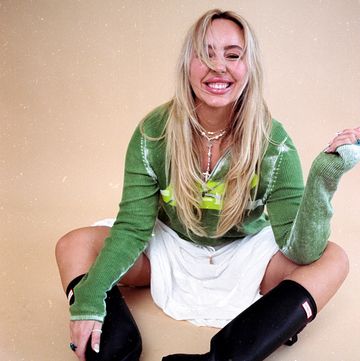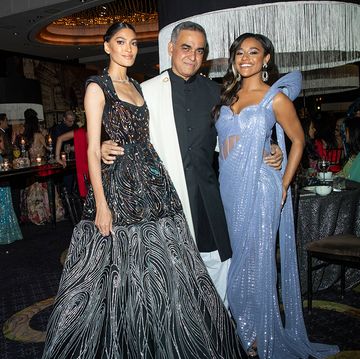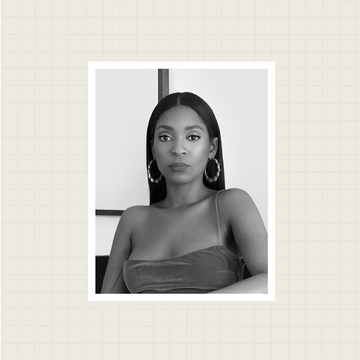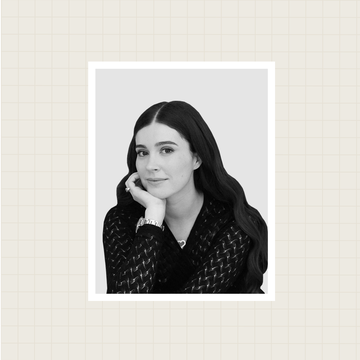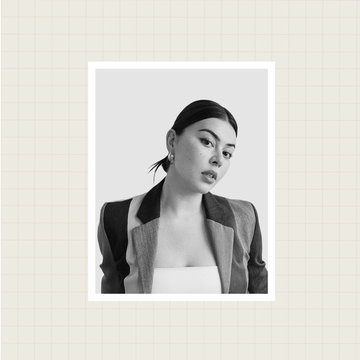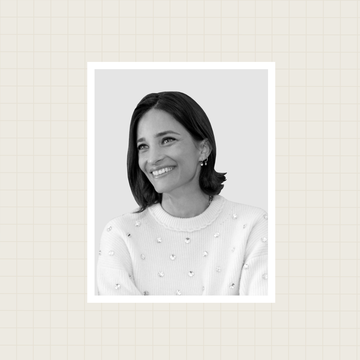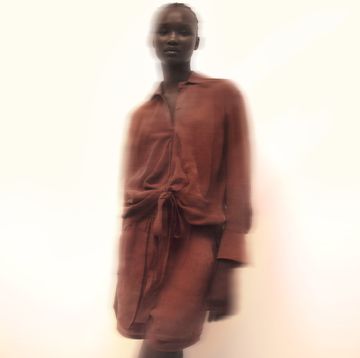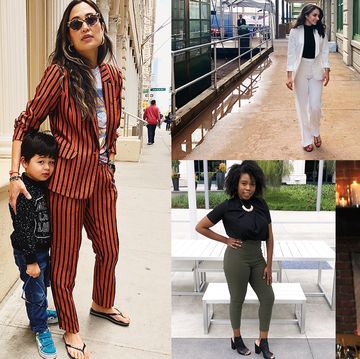On the fall runway at Saint Laurent, there were Madeline-perfect peacoats, Courtney Love circa "Doll Parts" velvet dresses with white collars, plaid minis, liberal polka dots, thick black school-girl tights, and shiny Maryjanes—every piece worn by a slip of a girl who looked a bit disheveled, as if she'd thrown it all together before heading out to the Paris streets. In his four seasons helming the house, Hedi Slimane has kept returning to the fascination of youth, the magnetic power of girlhood. And whenever that happens on fashion's main stage, a question inevitably arises: What grown woman wants to risk looking childish in an expensive designer dress?
That would be me.
In Slimane's models I see both my own look and that of the girls of my expatriate childhood—irreverent, oddly empowered, dressed for a bar yet too young to drink. I ask my friend the Carven designer Guillaume Henry— another French creative who returns to schoolgirl tropes season after season—to describe the look we both love. "It's maladroit," he says: gawky, a little sweet, like a baby giraffe struggling to stand, but also a little off, "like a girl growing up too fast." One might expect that a married 30-year-old with a baby son would balk at such a description, but I take it as the ultimate compliment. In the world of writers, there exists the idea that frivolity and intellect are a misaligned pair. So I play the devil and, at least with my appearance, the tease.
Photo: Saint Laurent schoolgirls; Courtesy of Imaxtree
The uniform I've worn more or less consistently since I was a girl growing up too fast consists of Peter Pan collars with navy V-necks, T-shirts with extralong sleeves to pull over my hands and hide my thumbs, tops that are sailor striped or cropped. I rarely wear pants; more often, it's shorts or flirty skirts or—even in winter—bloomers, lingerie tap shorts, rompers. To keep my legs warm, I have an assortment of knee-high socks and thigh-highs—striped, cashmere, garterless, some with fluorescent salmon seams, others with black embroidered snakes. My shoes are Converse, wrecked motorcycle boots, men's slipper flats or their opposite: platforms with the highest possible heel. For jewelry, I often wear only a black ribbon or a string around my neck, as I did when I was a teenager, and my wedding band is a simple black circle. I like to think of the effect as Lolita-girlish with a Deneuveian wink of icy, untouchable promiscuity.
Related: How a Closet Cleanse Helped Me Embrace My Thirties
Dressing this way both hides and highlights the things I value most about myself, which—despite the accusing looks of women on the street—aren't my legs, but rather my combative spirit, my sexuality, my curiosity. And it suits me well enough, since, like my mother before me, who got carded well into her thirties, I'm often mistaken for a student. My legs make up three quarters of my frame; my eyes take up half my face. With pale skin, red hair, gangly arms, and clumsy legs, I've been told I look like either a manga character or a high school senior. There is no mature beauty about me. Rather than mourn that fact, I dress to embrace it.
Not everyone gets it. Friends joke that I forgot to outgrow adolescence; one tweeted about a photo of me, "everyone's favorite Teen Mom, looking fly."
As for strangers, the reactions vary from bemused to outright offended. The cliché may hold that women dress for other women. Not me: I dress to please my own weird self. Certainly my husband would prefer me to dress in a more subdued way; our romance is fueled by my quirkiness, but not, as you might suspect, by my Lolita tendencies. He often interrogates me about what I intend to wear to important functions—like the floor-sweeping black Gucci gown with a deep-V neckline that was swiftly decreed "not appropriate" for a recent summer wedding—as a not-unwelcome hedge against my more risqué choices.
It's not my intention to alienate other women, but that's often the outcome. Not the young ones; it tends to be more established women who react to, say, a buttoned-up Peter Pan collar as if its slight whiff of subversion were an act of flagrant aggression. Maybe they read a certain Belle de Jour deviance into it—a taste for darkness, for forbidden men, for their men. Or maybe they, too, simply think I look "not appropriate." Undeniably, there's a small thrill, a tiny power in rejecting other women's standards, in playing the provocateur. And in knowing firsthand the one sure way to win the attention of every man and piss off every woman in any given room: Wear thigh-high socks.
It began when I was 11. That was the year I spotted the Vans-wearing, ripped-T-shirt-layering boy with the Leo DiCaprio-circa-1996 parted hair. I remember that my tiny white T-shirt revealed a sliver of stomach as I angled for him to notice me.
He didn't.
I had just enrolled in an international school in France, where my father was stationed for his job. Our uniform was red, white, and blue: usually a white button-down shirt, a red sweatshirt with a flocked-velvet Catholic school crest, a navy kilt. The standard riffs on this were baby tees, cable-knit thigh-highs, and platform Maryjanes.
Related: True Story: I Dress Like an 80 Year Old
Initially, I did not think this was a look I could pull off, an insecurity that was amplified when Leo-hair made fun of my flat chest and gawky limbs. Next to my more voluptuous classmates, those pre-teen vixens, I felt bookish and underdeveloped, which I was and continue to be.
Gradually, though, I began to realize that when I embraced the school uniform and stopped trying so hard to be something, anything, else, it worked. It helped that this was the '90s and fashion dovetailed nicely: It was the era of Versace's candy-hearts-pastel angora sweaters (and countless Clueless mall iterations)—picture Kate Moss and Naomi Campbell walking arm in arm in bright blue thigh-highs and plaid skirtsuits. Kate herself was a revelation, a one-woman shift in the beauty paradigm who made it seem possible that there was an upside to being built like I was.
As a nerdy teenager living overseas, I wasn't exposed to much American pop culture. We didn't have television to watch local shows, either, so I spent my Saturdays reading or at museums. I fell for the virgins in pastoral scenes of religious paintings, the dark angels of Gothic art, the nymphs of Greek mythology. My idols were Salinger's Franny, Phoebe, and Esmé.
Photo: The original movie poster; (c) Samuel Goldwyn Films/courtesy of the Everett Collection
At the movies, Dominique Swain was starring in the controversial Adrian Lyne take on Nabokov's Lolita. There was Baz Luhrmann's Romeo+Juliet. (Claire Danes' angel wings: transcendence!) But when I imagined Leo-hair and me "exploring our sexuality together," whatever that meant, the vision was informed—and, yes, this sounds ridiculous—by FrancoZeffirelli'sRomeo and Juliet, the version we'd watched in English class.
The actresses in these films looked innocent, like me, but they encountered love that was pure, unbridled, wild. They knew things they shouldn't. They were nymphs and angels, androgynous yet sexy. Young but prematurely jaded, they had a power over men that I was only beginning to understand.
Related: The Bride Who Wore Red
After Leo-hair, I gave up on being visible to boys and set my sights irrevocably on something else: Men. Solid, quiet, strong, older men. My body may have betrayed me, but I believed I could seduce with my mind. I read the same books as adults did! I knew things! I may not have gotten Seinfeld references, but I could recite most lines from La Reine Margot. I began to long for the social-studies teacher to "take me" in the back room. He was a philosophy PhD candidate with long hair and wire-rimmed glasses, the first person to tell me about Walter Benjamin, an obsession that continues to this day. He was also extremely ethical and upright (the same was true of the French teacher I later fixated on in high school), which was perhaps a self-selecting criteria for my own preservation. It insured that my Lolita leanings remained purely cerebral. I was the product of strict parents obsessed with academic success, a little too well behaved to act on such impulses anyway. Instead, I was left with a lot of longing and those same Bambi legs.
Today, my look has much to do with reexamining that adolescent self, laying claim to what she could not. By and large I still look the way I did then. But now I know how to use it to my advantage.
Not that I want to seduce, exactly. But should I happen to mess with men a little? That's okay. One thing's for sure: My look significantly lowers their expectations.
Here's how it always starts: "Are you a student? An actress? A model?"
"A writer," I reply, to raised eyebrows and that look—You poor, delusional girl. So is everyone in this town—followed swiftly by: "Want to have a drink?" When I say no, thanks, what I'm really thinking is, Go on, underestimate me. Think me dumb, shallow, pliable, an easy score. For me, the pleasure is in knowing that he'll soon find out I'm none of those things.
Photo: The author in her beloved eyebrow-raising legwear; one of her many risqué muses: Balthus' Thérèse Dreaming (1938)
A friend well versed in art history said to me not long ago, "You know, you dress like a Balthus girl." At the time, the twentieth-century painter was having a moment: The Metropolitan Museum of Art had just opened "Balthus: Cats and Girls—Paintings and Provocations," and the Gagosian Gallery was showing the Polaroid studies he did late in life.
Balthus girls are just that—girls. Young Parisians unwittingly (or, I suspect, complicitly) sensual under the artist's gaze. They're often depicted reclining in collared shirts, skirts, kneesocks, or nothing at all. And they're controversial, of course, erotic yet innocent, always flirting with the edge of something dark, in scenarios open to interpretation. But it's their aloofness that speaks to me. Their beauty is not about perfect symmetry or womanly curves, but rather is based on a sense of mystery, of haunting, premature world-weariness. When I was young, I wanted to project this kind of knowing. As an adult I want to reverse it, to convey a naive spirit open to the promise of what's still to come.



